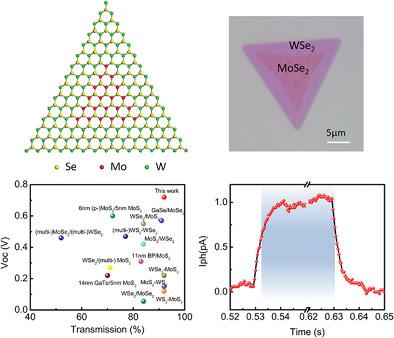Our official English website, www.x-mol.net, welcomes your
feedback! (Note: you will need to create a separate account there.)
Lateral Monolayer MoSe2 -WSe2 p-n Heterojunctions with Giant Built-In Potentials.
Small ( IF 13.0 ) Pub Date : 2020-07-21 , DOI: 10.1002/smll.202002263 Shuai Jia 1 , Zehua Jin 1 , Jing Zhang 1 , Jiangtan Yuan 1 , Weibing Chen 1 , Wei Feng 2 , Pingan Hu 2 , Pulickel M Ajayan 1 , Jun Lou 1
Small ( IF 13.0 ) Pub Date : 2020-07-21 , DOI: 10.1002/smll.202002263 Shuai Jia 1 , Zehua Jin 1 , Jing Zhang 1 , Jiangtan Yuan 1 , Weibing Chen 1 , Wei Feng 2 , Pingan Hu 2 , Pulickel M Ajayan 1 , Jun Lou 1
Affiliation

|
2D transition metal dichalcogenides (TMDs) have exhibited strong application potentials in new emerging electronics because of their atomic thin structure and excellent flexibility, which is out of field of tradition silicon technology. Similar to 3D p–n junctions, 2D p–n heterojunctions by laterally connecting TMDs with different majority charge carriers (electrons and holes), provide ideal platform for current rectifiers, light‐emitting diodes, diode lasers and photovoltaic devices. Here, growth and electrical studies of atomic thin high‐quality p–n heterojunctions between molybdenum diselenide (MoSe2) and tungsten diselenide (WSe2) by one‐step chemical vapor deposition method are reported. These p–n heterojunctions exhibit high built‐in potential (≈0.7 eV), resulting in large current rectification ratio without any gate control for diodes, and fast response time (≈6 ms) for self‐powered photodetectors. The simple one‐step growth and electrical studies of monolayer lateral heterojunctions open up the possibility to use TMD heterojunctions for functional devices.
中文翻译:

具有巨大内置电位的横向单层MoSe2 -WSe2 pn异质结。
2D过渡金属二硫化碳(TMD)由于其原子薄的结构和出色的柔韧性而在新兴的电子产品中显示出强大的应用潜力,这已超出了传统硅技术的领域。与3D p–n结类似,通过横向连接TMD与不同的多数电荷载流子(电子和空穴)来实现2D p–n异质结,这为电流整流器,发光二极管,二极管激光器和光伏器件提供了理想的平台。这里,原子薄高品质的p-n二硒化钼(MOSE之间的异质结的生长和电研究2)和二硒化钨(WSE 2)通过一步化学气相沉积方法进行了报道。这些p–n异质结具有很高的内置电势(≈0.7eV),从而导致电流整流比大,而无需对二极管进行任何栅极控制,并且对自供电光电探测器的响应时间短(≈6ms)。单层横向异质结的简单一步生长和电学研究为将TMD异质结用于功能器件提供了可能性。
更新日期:2020-08-27
中文翻译:

具有巨大内置电位的横向单层MoSe2 -WSe2 pn异质结。
2D过渡金属二硫化碳(TMD)由于其原子薄的结构和出色的柔韧性而在新兴的电子产品中显示出强大的应用潜力,这已超出了传统硅技术的领域。与3D p–n结类似,通过横向连接TMD与不同的多数电荷载流子(电子和空穴)来实现2D p–n异质结,这为电流整流器,发光二极管,二极管激光器和光伏器件提供了理想的平台。这里,原子薄高品质的p-n二硒化钼(MOSE之间的异质结的生长和电研究2)和二硒化钨(WSE 2)通过一步化学气相沉积方法进行了报道。这些p–n异质结具有很高的内置电势(≈0.7eV),从而导致电流整流比大,而无需对二极管进行任何栅极控制,并且对自供电光电探测器的响应时间短(≈6ms)。单层横向异质结的简单一步生长和电学研究为将TMD异质结用于功能器件提供了可能性。


















































 京公网安备 11010802027423号
京公网安备 11010802027423号